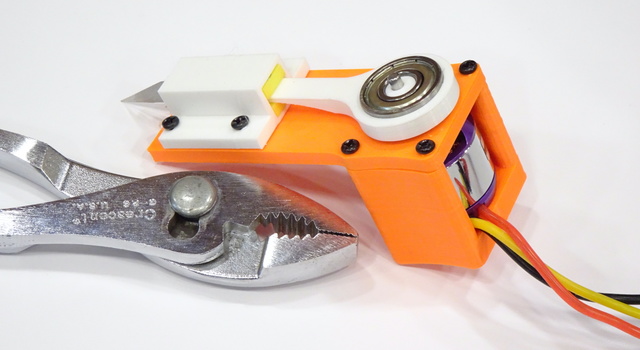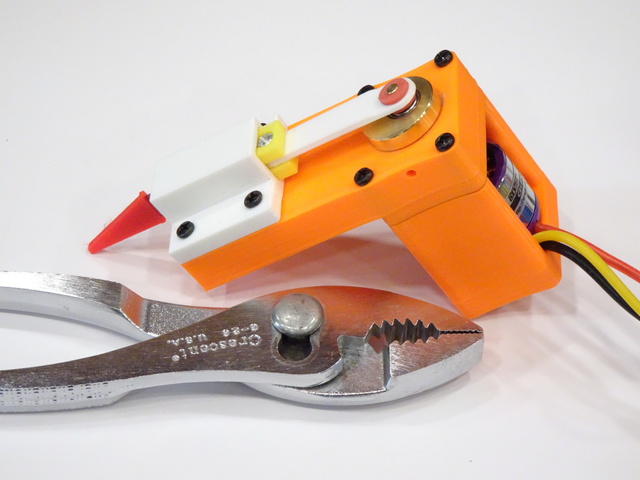Last fall when I was looking for ways to drive a reciprocating fabric cutter, Ed Nisley suggested that I look at hobby brushless DC motors as possible sources of enough of both speed and torque. Not knowing anything about their care and feeding (and after a significant delay), I did my homework and learned how to lash one together well enough to make it spin.
After which I inevitably put together a completely unusable cutterhead prototype.
My intent all along was to use the same tattoo gun brass cam as on the tiny motors, but last weekend I couldn’t find a tiny hex key for the set screw to remove it from the previous prototype and affix it to the BLDC motor. It being a very short drive from Missingtherighttoolville to neighboring Badideatown, I printed a plastic cam and new connecting rod to fit a standard skate bearing. Let me tell you, turning on that cutter was like holding a powerful vibrating thing with a razor-sharp blade in your hand.
It didn’t cut the fabric particularly well, either. It had plenty of torque but lacked either sufficient speed or travel to cut unclamped fabric; it just shoved it out of the way. (It cut just fine when the fabric was held in tension, but that’s not the objective.) The eccentric mass of that heavy skate bearing did not motivate me to turn it up faster, particularly when I already had the other cam in mind.
Since I was missing the hex key for the brass tattoo cam’s set screw and since somehow I’ve never had more than a few random hex keys, I ordered a cheap collection. When they arrived the next day, I removed the cam from the tiny gearmotor and discovered that the BLDC motor doesn’t have the 3-mm shaft it looks like it does. No, it’s 3.175 mm, aka why is the world manufacturing new high-tech products with tapped metric holes and a 1/8″ axle???
I ordered more stuff — a 1/8″ end mill bit to drill out the cam again and a pack of 1/8″ ID bearings to support the motor axle near the tip, since the eccentric load was going to be pretty far from the motor’s internal bearing and the 3-mm-ID bearings I’d just bought were going to require too much force to get onto that shaft.
This morning I finished printing new mounting parts, did a sloppy job of milling out the cam on the Dremel drill press (you’d think I’d get something better-suited for precision work), and fitted everything together. Unfortunately, the tip of the motor axle is filleted and the cam can’t be drilled very deep; and the 1.5-mm hex key is poorly manufactured and can’t tighten the set screws well; so even after borrowing a second set screw from my other cam, the cam works itself loose from the motor shaft before I can get the assembly up to a high speed or do more than the briefest test cut. To that point, it was vibrating less; but more less would still be preferable.
I’ve now ordered a set of small Wiha hex keys (I’m done messing around with the cheap ones), some spare set screws, and a counterbalanced tattoo cam.

